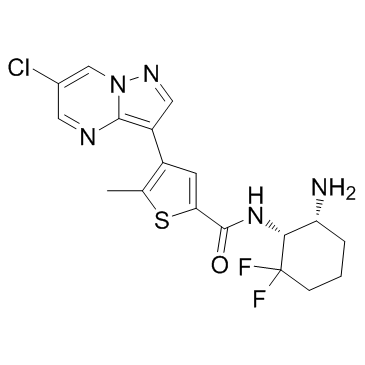MARK-IN-2 |
| Catalog No.GC31280 |
MARK-IN-2 is a potent microtubule affinity regulating kinase (MARK) inhibitor with an IC50 of 5 nM.
Products are for research use only. Not for human use. We do not sell to patients.

Cas No.: 1314893-26-9
Sample solution is provided at 25 µL, 10mM.
MARK-IN-2 is a potent microtubule affinity regulating kinase (MARK) inhibitor with an IC50 of 5 nM.
MARK-IN-2 (Compound 27) is a potent MARK inhibitor. Inhibition of MARK represents a potentially attractive means of arresting neurofibrillary tangle pathology in Alzheimer's disease. MARK-IN-2 inhibits MARK3 with an IC50 of 5 nM. MARK-IN-2 also inhibits MARK3 in primary cell culture of rat cortical neurons with an IC50 of 280 nM[1].
Characterization of the i.v. pharmacokinetic properties of MARK-IN-2 in rat and dog reveals reasonable volumes of distribution but moderate to high clearance and short half-lives. MARK-IN-2 (Compound 27) has moderate terminal elimination half-life (t1/2=0.7 h, and 1 h for rat and dog) [1].
[1]. Sloman DL, et al. Optimization of microtubule affinity regulating kinase (MARK) inhibitors with improved physical properties. Bioorg Med Chem Lett. 2016 Sep 1;26(17):4362-6.
Average Rating: 5 (Based on Reviews and 39 reference(s) in Google Scholar.)
GLPBIO products are for RESEARCH USE ONLY. Please make sure your review or question is research based.
Required fields are marked with *




















